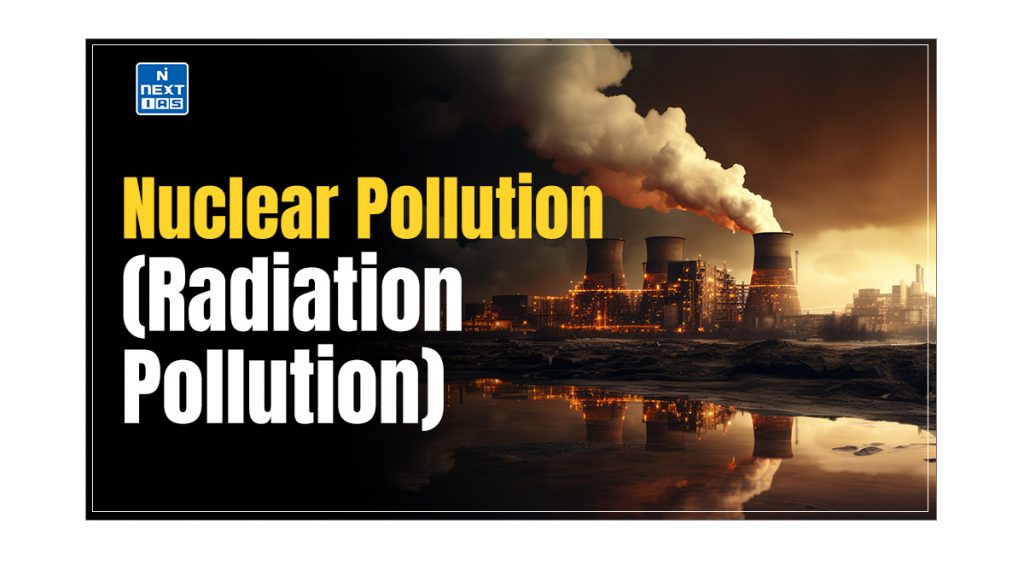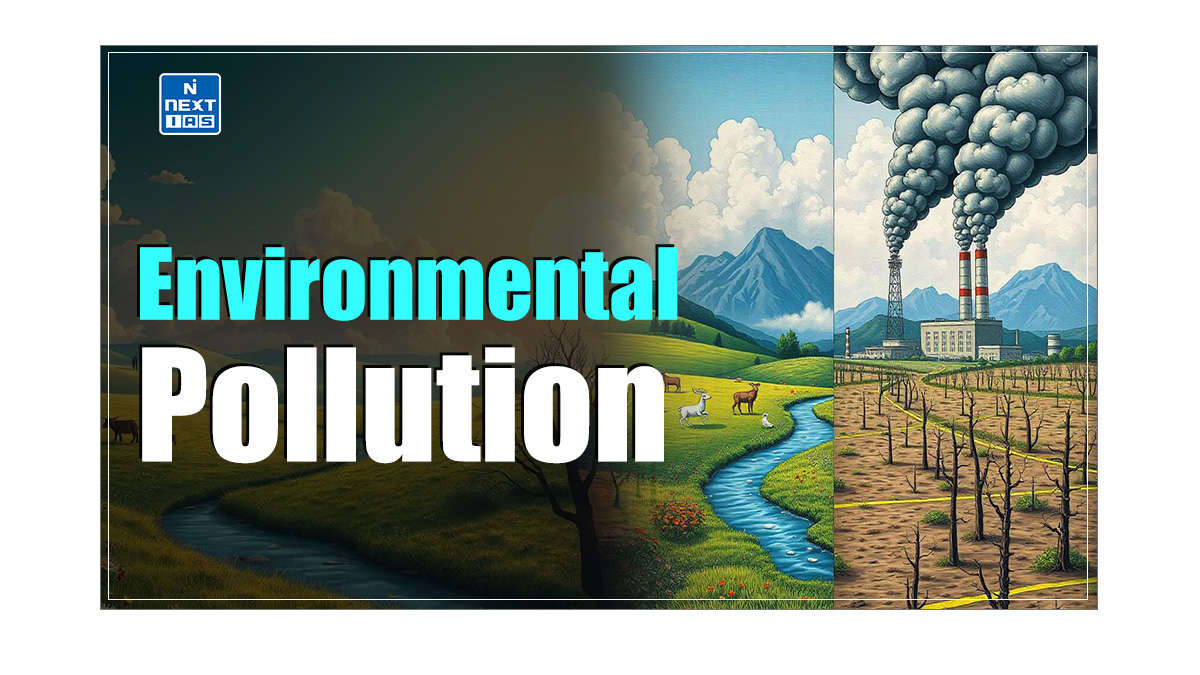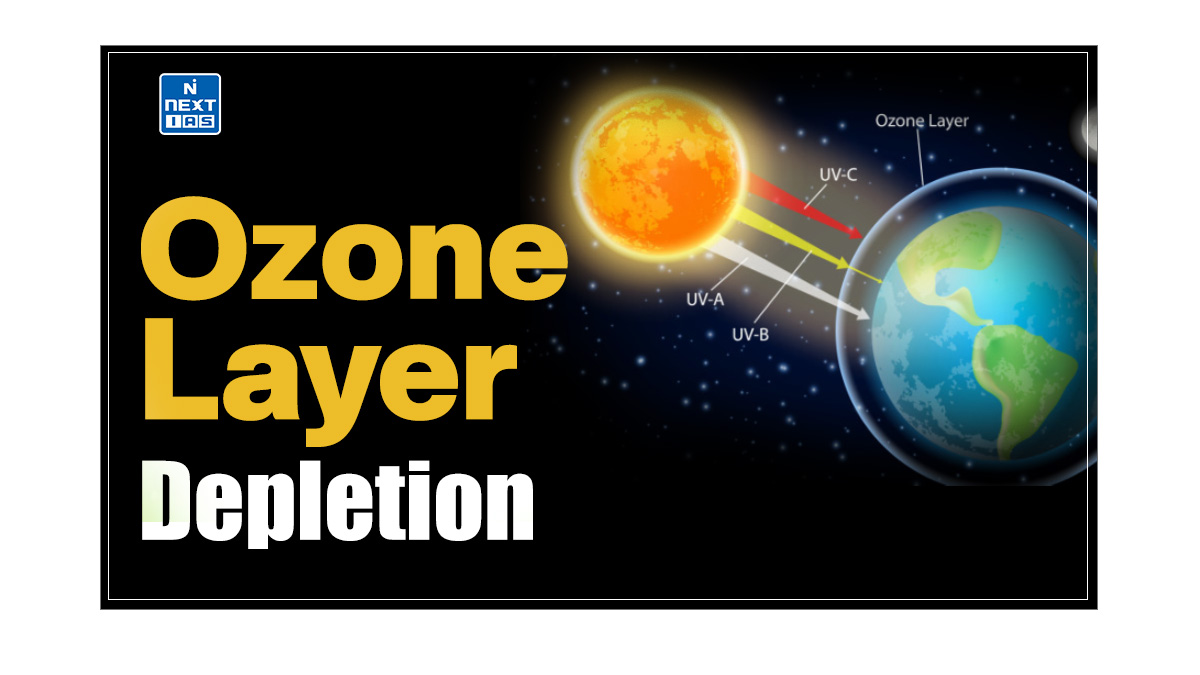
As societies become increasingly industrialised, Nuclear Pollution (Radiation Pollution) has emerged as a significant environmental issue. It has wide-ranging implications for humans, wildlife, and the environment. This article aims to study in detail Nuclear Pollution (Radiation Pollution), its major causes and sources, effects, control measures, and other related aspects.
What is Nuclear Pollution (Radiation Pollution)?
- Nuclear Pollution or Radiation pollution can be defined as the release of high-energy particles into the air, water, or surface.
- Nuclear Pollution can also be defined as the release and accumulation of radioactive substances in the environment, posing serious health risks to humans, animals, and ecosystems.
- This form of nuclear pollution primarily involves the leakage of radiation into the environment.
- Nuclear Pollution is a prominent type of Environmental Pollution.
| What is Environmental Pollution? – Environmental Pollution refers to the introduction of harmful materials into the environment. – In other words, it is the contamination of the physical and biological components of the environment to such an extent that normal environmental processes are adversely affected. – Environmental pollution can be categorised into several types based on the nature of the pollutants and the media they affect, including Air Pollution, Soil Pollution, Water Pollution, etc. Read our detailed articles on Environmental Pollution, Soil Pollution, Water Pollution, Air Pollution, Noise Pollution, Thermal Pollution, Marine Pollution, and Plastic Pollution. |
Sources of Nuclear Pollution (Radiation Pollution)

- Nuclear Pollution is caused when radioactive matter contaminates the environment by decaying naturally or due to anthropogenic activities.
- Breaches at nuclear power plants can result in seepage of radioactive matter into the environment, causing Nuclear Pollution.
- Chemical spills can also cause radiation or nuclear pollution.
- Not conducting scientific experiments involving radiation with proper care.
- A prominent example is the case of scientist Marie Curie, whose studies into the curative effects of radiation caused her to fall ill from radiation poisoning.
Effects of Nuclear Pollution (Radiation Pollution)
- Radiation modifies and destroys cells in living organisms, resulting in illness or death.
- Nuclear Pollution can cause genetic mutations in living organisms and their offspring.
- Nuclear Pollution can also have a burning effect.
- Nuclear Pollution can leave soil infertile and unfit for crops for several decades.
- Nuclear Pollution can leave the air dangerous to breathe.
Measures to Control Nuclear Pollution (Radiation Pollution)
- Safe storage of radioactive pollutants.
- Clear warnings should be displayed everywhere where such material is possible.
- Alternative energy sources should be focused on instead of reliance on nuclear energy.
- Nuclear tests should be strictly monitored and done underground.
- Production of radioisotopes should be minimised.
- Extreme care should be exercised in the disposal of wastes containing radionuclides.
- Nuclear medicines and radiation therapy should be applied when necessary.
Conclusion
Nuclear Pollution or Radiation Pollution represents a significant environmental and health challenge with far-reaching implications. Addressing this issue requires a combination of stringent regulatory measures, technological innovations, and effective waste management practices. By understanding the sources, impacts, and solutions for nuclear pollution, societies can work towards minimising risks, protecting public health, and ensuring a safer and more sustainable future.
Nuclear Hazard
- Nuclear Hazard is the risk or danger posed by radiation emission from atomic nuclei or an uncontrolled explosion from a fusion/fission reaction of atomic nuclei, which jeopardises human health or the environment.
- The resulting energy from the atomic reaction, also called nuclear energy, can be beneficial or harmful, depending on how it is used.
- While we routinely use X-rays to examine bone for fractures, treat cancer with radiation, and generate electrical energy (approximately 17% of the electrical energy generated in the world comes from nuclear power plants), the radioactive waste from nuclear energy has caused and continues to cause serious environmental damage.
- Although nuclear power is being used today as a reliable source of electricity, several serious accidents have caused worldwide concern about the safety and disposal of radioactive waste.
Nuclear Waste
Sources of Nuclear Waste
- Operations conducted by nuclear power stations produce radioactive waste.
- Nuclear fuel reprocessing plants are the biggest sources of man-made nuclear waste.
- Mining and refining of uranium and thorium also causes nuclear waste.
- Waste is also produced in the nuclear fuel cycle, which is used in many industrial, medical and scientific processes.
- Spent nuclear fuel is dangerously radioactive, and it remains toxic for many years.
Nuclear Waste Control Measures
- Reprocessing discarded fuel rods has been thought to provide new fuel to the reactor.
- Reduce the overall nuclear waste.
Challenges with Nuclear Waste Management
- The cost of reprocessing is higher than producing directly from the core.
- Additionally, there is a risk of exposure to harmful radiation to health and the environment at each step in the cycle.
- Presently, India operates reprocessing plants to reprocess discarded rods instead of storing them as nuclear waste.
What is Radiation?
- Radiation is the process by which radiant energy is transferred from one place to another in the form of electromagnetic waves.
- There are various forms of radiation depending on their wavelengths.
- The shorter the wavelength, the higher its energy and, thus, the higher the pollution potential.
Types of Radiations
Radiation can be categorised into two groups – Non-Ionising Radiation and Ionising Radiation.

Non-Ionising Radiation
These are created by the electromagnetic waves at the longer wavelength of the spectrum, ranging from near infra-red rays to radio waves.
These waves have energies enough to excite the atoms and molecules of the medium through which they pass, causing them to vibrate faster but not strong enough to ionise them e.g. Microwaves.
Ionising Radiation
These are of shorter wavelengths and cause ionisation of atoms and molecules of the medium through which they pass. Eg. X rays and gamma rays.
Types of Radiation Particles

Alpha
- It contains energetic particles.
- Each alpha particle carries two units of positive charges and interacts strongly with living tissues.
Beta
- It is made up of energetic electrons.
- Each beta particle carries one unit of negative charge and interacts strongly with matter.
Gamma
- These are made up of high-energy photons.
- Photons bring about strong electromagnetic interaction with matter.
Sources of Radioactive Pollution
- Radioactive pollution primarily stems from various sources, both natural and human-made.
- Natural sources include cosmic rays from outer space, radon gas from the Earth’s crust, and naturally occurring radioactive materials (NORM) like uranium, thorium, and radium found in rocks, soil, and water.
- Human-made sources are more significant contributors to radioactive pollution.
- These include nuclear power plants, where accidents like the Chernobyl and Fukushima disasters have caused severe contamination, as well as nuclear weapons testing that releases radioactive fallout into the atmosphere.
- Other sources include improper disposal of radioactive waste from medical, industrial, and research applications and mining and refining of uranium.
- Radioactive pollution is hazardous due to the long-lasting effects of radiation on human health and ecosystems.
Notable Nuclear Incidents
Chernobyl Disaster (1986)
- On 25 April 1986, a series of mishaps and errors resulted in overheating of the core, leading to an uncontrollable reaction in the reactor despite emergency systems being put in place to stop it.
- In a matter of a few seconds (4.5 seconds), the energy level of the reactor increased two thousand times!
- The resulting explosion led to the world’s worst nuclear accident.
- The long-term consequences were devastating, including genetic anomalies in generations to come.
Three Mile Island Disaster (1979)
- The disaster took place at Three Mile Island in Middletown, USA.
- The leakage from the reactor was apparently low, and no one was injured immediately.
- It led to new regulations for the nuclear industry.
Fukushima Daiich Disaster (2011)
It was an accident at the Fukushima Daiichi Nuclear Power Plant in Fukushima, initiated primarily by the tsunami following the Earthquake on 11 March 2011.
Frequently Asked Questions (FAQs)
What is Radiation?
Radiation is energy emitted in the form of waves or particles. It can be non-ionizing (e.g., radio waves) or ionising (e.g., X-rays, gamma rays).
What is Nuclear Pollution?
Nuclear pollution, or radioactive pollution, occurs when radioactive substances are released into the environment, often due to nuclear power plants, accidents, improper waste disposal, or nuclear weapons testing.
How to Prevent Nuclear Pollution?
Preventing nuclear pollution involves strict safety protocols in nuclear power plants, ensuring proper storage and disposal of radioactive waste, using alternative energy sources, conducting regular maintenance, and monitoring for leaks or emissions.
Does Nuclear Energy Cause Air Pollution?
Nuclear energy does not produce traditional air pollutants like carbon dioxide or particulate matter during its operation. However, mining and processing nuclear fuel, as well as managing radioactive waste, have indirect environmental impacts.
How is Pollution Created Due to Radiation?
Nuclear Pollution from radiation occurs when radioactive particles are released into the air, water, or soil. This can happen through accidents at nuclear power plants, improper disposal of radioactive waste, mining, or nuclear weapons testing, allowing radioactive materials to enter ecosystems and potentially contaminate living organisms.






